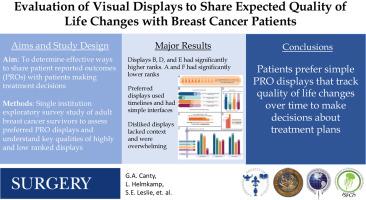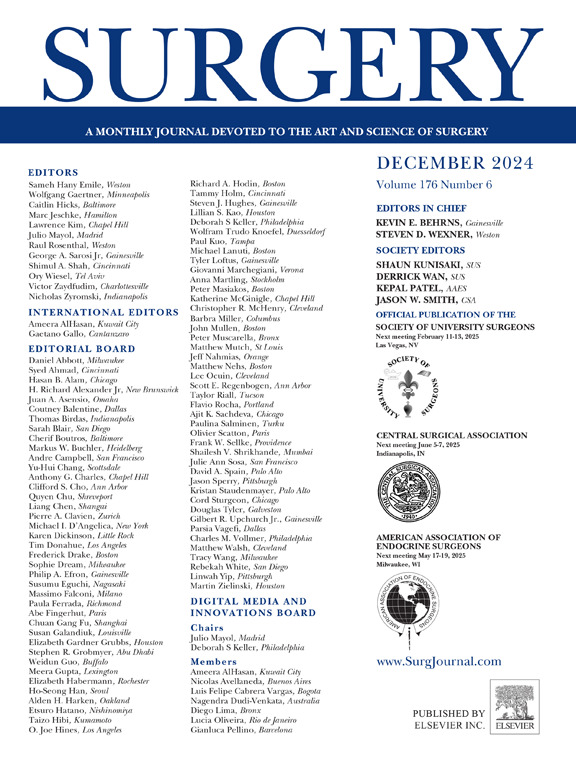评估视觉显示以分享乳腺癌患者预期的生活质量变化
IF 2.7
2区 医学
Q1 SURGERY
引用次数: 0
摘要
背景:对于决定乳房切除术和保乳治疗的患者,结合预期的术后患者报告的结果可能有助于共同决策。我们的目标是了解患者如何与各种患者报告的结果显示风格相互作用,以支持乳腺手术决策辅助工具的发展。方法一个多学科团队在选定的BREAST-Q域开发了6个患者报告结果数据的可视化显示。在学术机构接受治疗的0-III期乳腺癌患者接受问卷调查,评估他们对患者报告的结果显示的偏好。从电子健康记录中提取人口统计变量。使用平均值、标准差和Plackett-Luce模型对排名数据进行比较,并使用Bonferroni校正来解释两两比较。通过一般线性模型评估人口统计学和癌症变量的排名差异。通过专题分析评估了不限成员名额的答复。结果共59人完成问卷调查,回复率为17%。三个显示器的平均排名显著较高(更受欢迎),但它们之间没有统计学上的显著差异;6个显示器中的2个具有明显较低(不太受欢迎)的等级。对不同患者报告结果显示的偏好和患者人口统计学或疾病相关变量之间没有发现差异。在开放式评论中,患者报告了对简单显示和纵向患者报告结果数据的偏好;患者不喜欢显示的信息要么太少,要么太多。结论具有纵向患者报告结果的显示是患者的首选,而具有多个BREAST-Q域的显示是压倒性的,因此不太受欢迎。患者一般偏好每图3 - 4个数据值。没有“放之四海而皆准”的方法,因为一些患者报告的结果显示排名很高。进一步研究患者如何解释多变量数据是必要的,以了解不同患者群体的需求。本文章由计算机程序翻译,如有差异,请以英文原文为准。

Evaluation of visual displays to share expected quality of life changes with patients with breast cancer
Background
For patients deciding between mastectomy and breast conserving therapy, the incorporation of expected postoperative patient-reported outcomes may facilitate shared decision-making. We aim to understand how patients interact with a variety of patient-reported outcome display styles to support the development of decision aids for breast surgery.
Methods
A multidisciplinary team developed 6 visual displays of patient-reported outcome data in select BREAST-Q domains. Patients with stage 0–III breast cancer treated at an academic institution received questionnaires assessing their preferences for the patient-reported outcome displays. Demographic variables were extracted from the electronic health record. Display rankings were compared using means, standard deviations, and the Plackett-Luce model for ranked data with Bonferroni corrections to account for the pairwise comparisons. Differences in rankings by demographic and cancer variables were assessed by general linear models. Open-ended responses were assessed by thematic analysis.
Results
A total of 59 participants completed the questionnaire (Response rate: 17%). Three displays had significantly higher (more preferred) mean ranks without statistically significant differences among them; 2 of the 6 displays had significantly lower (less preferred) ranks. No differences were found between preference for different patient-reported outcome displays and patient demographic or disease-related variables. In open-ended comments, patients reported a preference for simple displays with longitudinal patient-reported outcome data; patients disliked displays that either had too little or too much information.
Conclusion
Displays with longitudinal patient-reported outcomes were preferred by patients, whereas displays with multiple BREAST-Q domains were overwhelming and therefore were less preferred. Patients generally preferred 3 to 4 data values per figure. There is no “one size fits all” approach, because several patient-reported outcome displays ranked highly. Further research on how patients interpret multivariable figures is warranted to understand the needs of diverse patient populations.
求助全文
通过发布文献求助,成功后即可免费获取论文全文。
去求助
来源期刊

Surgery
医学-外科
CiteScore
5.40
自引率
5.30%
发文量
687
审稿时长
64 days
期刊介绍:
For 66 years, Surgery has published practical, authoritative information about procedures, clinical advances, and major trends shaping general surgery. Each issue features original scientific contributions and clinical reports. Peer-reviewed articles cover topics in oncology, trauma, gastrointestinal, vascular, and transplantation surgery. The journal also publishes papers from the meetings of its sponsoring societies, the Society of University Surgeons, the Central Surgical Association, and the American Association of Endocrine Surgeons.
 求助内容:
求助内容: 应助结果提醒方式:
应助结果提醒方式:


